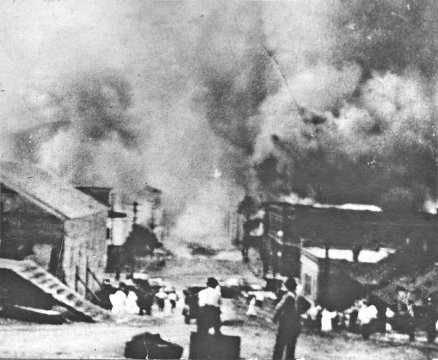historic photos courtesy of Baker County Library
I don’t really like to talk about the 1917 fire. I definitely don’t like to look at pictures of the aftermath. But the fire is as much a part of the history of Sumpter as the rest of the months and years of her existence.
Fire was ever the enemy of the wooden towns of the Old West. The drive to get buildings up and get them up quick led to many “innovations.” Why put up two separate walls when one wall could serve two buildings? And that meant cold air couldn’t come in through the gap between buildings, either. Trees were tall and plentiful. Just cut studs for framing tall enough to stretch from the bottom of the wall to the top, even if the top was twenty or more feet up.
To a fire, this balloon construction of continuous studs from base to roof was an open invitation to leap as high as flames could reach. If a wall happened to be insulated, it was usually with paper or sawdust. Most sidewalks, if they existed, were wooden. Sumpter had a high class two blocks of businesses where even crossing the street you were above the mud on 4” by 4” thirty-foot lengths of planking.
As mentioned in “Early and Later,” the planking of Granite St from Mill to Cracker started in 1900. The piles of planking are shown in below left photo taken in March or April of 1900. Construction of the Sumpter Hotel has not yet been started. The photo below right was taken in 1906 from just a little farther east than the left-hand photo. From the higher angle, the planked street looks very smooth. The Sumpter Hotel has been open for four years. Both photos are of Granite St looking west from Mill St.
At approximately one o’clock on the afternoon of Aug 13, 1917, a fire started in the Capital Hotel and spread rapidly. According to Miles F. Potter in Oregon’s Golden Years, it took only three hours to destroy twelve blocks of businesses and homes, causing an estimated loss of $500,000. The photos below were taken from the steps of the school and show the spread of the fire across Granite St.
People removed items from many buildings, storing them within the brick walls of the Sumpter Hotel. But it, too, burned.
Sumpter Hotel, 1901
Sumpter Hotel, 1917 (First National Bank in background)
First National Bank, 1906 First National Bank, 1926
What good does it do to string hose across a street to fight fire when the street itself is burning? How do you counter August heat and afternoon winds? In the end, it is said, they used dynamite to keep the fire from spreading into the forested hills surrounding town.
From the river to Columbia Street, Granite Street lost: Baird’s store, John Arthur’s The Louvre (wine and women), Cato Johns’ store, Hickock Hardware, Sullivan Brothers (the toughest saloon in town), Tedrowe Hotel Bar, Capital Hotel* and Bar, Starr* Hotel, Gagan & Sloan Saloon (previously Kentucky Liquor Store and previous to that Phoenix Saloon), Portland Café (lunch for twenty-five cents), Gem Saloon, Sumpter Meat Co., a barbershop, a shoe store, the Oregon Restaurant, First National* Bank, W.R. Hawley Store and Hobson Mercantile Co (shared brick building), the post office (in what had once been Columbia Market*), Bank Saloon, Board of Trade Saloon, Elite Cigar Store, Beamer’s Harness Shop (previously Hub Clothing Store), Vienna Café, Mercer Drugs, Landreth & Campbell Jewelry, The Club Saloon, Anna Weigand’s dress shop, Sumpter* Hotel, Edwards Drugs and Soda Fountain, C.P. Holly’s Harness Shop (once Dick Neill’s dry goods*), Ellis Opera House, the brick Sumpter Power & Water office, and the homes of Dr L.F. Brock, Clark Snide, and George Peet. Across Columbia St, the hospital* and school* survived.
There were other losses and other saves, but those are for another time.
*tagged in photographs in this and previous articles From Auburn Street; information on which businesses existed came from Brooks Hawleys’s 1965 map











great account of the historic fire!
thanks for the great history lesson!
such tragedy…!
Beamer’s Harness Shop belonged to my great-grandfather, Marion Beamer who moved to Sumpter around 1899 from Salem, Oregon. Are there any pictures of his shop?
Sorry it’s been a year. Hope you’re still out there. I don’t recognize the name, but I’ll sure keep an eye out for it.